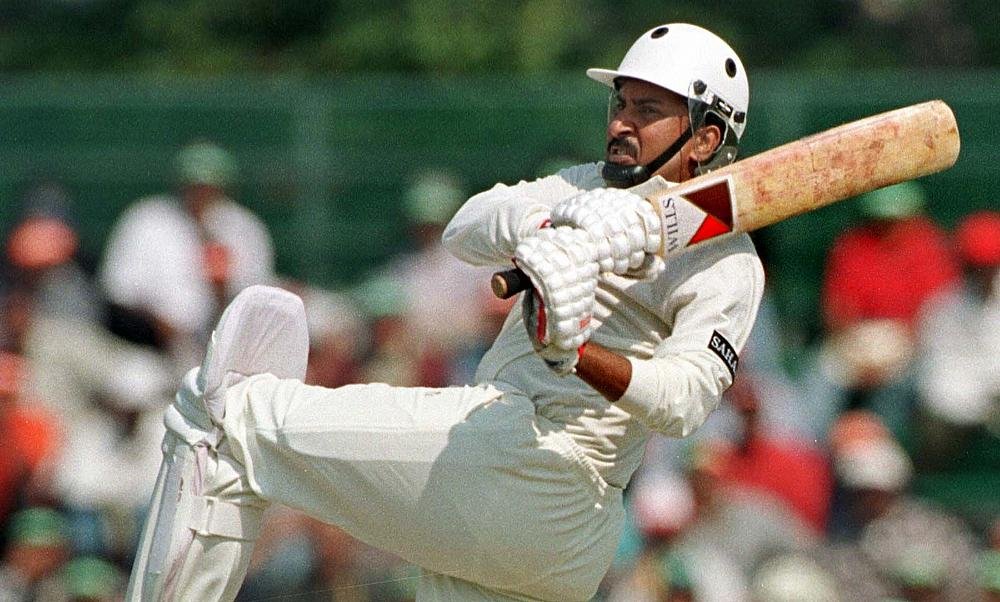
I do not like Neville Cardus.
Cardus had a beautiful style. But he also made up facts.
In fact, he did it so often that his fabrications resulted in a book.
See what I mean? Not many cricket writers have achieved this.
Please read on.
+

Cardus had a beautiful style. But he also made up facts.
In fact, he did it so often that his fabrications resulted in a book.
See what I mean? Not many cricket writers have achieved this.
Please read on.
+


Over time, I have managed to accept the fact that I shall never be able to keep up with the Cardusians.
We are different people.
We approach cricket literature with different priorities.
I had decided to leave it at that.
But something curious happened a couple of days ago.
+
We are different people.
We approach cricket literature with different priorities.
I had decided to leave it at that.
But something curious happened a couple of days ago.
+
I was flipping through A Cricketer’s Companion (edited by Christopher Martin-Jenkins) when I came across a Cardus piece on Johnny ‘JT’ Tyldesley.
You may also find the piece in A Fourth Innings with Cardus.
But first, something about Tyldesley.
+
You may also find the piece in A Fourth Innings with Cardus.
But first, something about Tyldesley.
+

Tyldesley played 31 Tests, and scored almost 38,000 runs in First-class cricket.
He still has the second-most runs, hundreds, and fifties for Lancashire (only Ernest, his brother, has more).
He was among the colossi of pre-War cricket.
+
He still has the second-most runs, hundreds, and fifties for Lancashire (only Ernest, his brother, has more).
He was among the colossi of pre-War cricket.
+
He is largely forgotten today, though his great-great-nephew Michael Vaughan has kept him relevant in quizzing circles.
But let us return to Cardus.
It was the first Cardus piece I had read in a few years. I remembered why so many people swear by Cardus.
+
But let us return to Cardus.
It was the first Cardus piece I had read in a few years. I remembered why so many people swear by Cardus.
+
There is little doubt that he was a brilliant writer.
Sample this:
‘For Tyldesley a bat was an honest broadsword – a broadsword drawn in no service but the service of Lancashire.’
The piece ends with insights on Tyldesley the person and his characteristic modesty:
+
Sample this:
‘For Tyldesley a bat was an honest broadsword – a broadsword drawn in no service but the service of Lancashire.’
The piece ends with insights on Tyldesley the person and his characteristic modesty:
+

A most likeable man, then, Tyldesley.
While reading this, however, I could not overlook the fact that to prove a point, Cardus had resorted to a scorecard – an entity he had at least once dismissed as ‘an ass’.
I chuckled, then set out to be obtain the scorecard.
+
While reading this, however, I could not overlook the fact that to prove a point, Cardus had resorted to a scorecard – an entity he had at least once dismissed as ‘an ass’.
I chuckled, then set out to be obtain the scorecard.
+
I was curious about the outcome of this match against Worcestershire.
Johnny Tyldesley had scored only one double hundred against Worcestershire, 248 at Liverpool in 1903.
But the Lancashire top five read Garnett, Spooner, Tyldesley, MacLaren, and Hornby.
+
Johnny Tyldesley had scored only one double hundred against Worcestershire, 248 at Liverpool in 1903.
But the Lancashire top five read Garnett, Spooner, Tyldesley, MacLaren, and Hornby.
+
There was no Poidevin or Sharp, and both were mentioned in Tyldesley’s report.
A misprint, then, perhaps?
Maybe it was really a hundred and not a double-hundred?
Perhaps Cardus wanted to type ‘100’ after Tyldesley… and there was an error somewhere?
+
A misprint, then, perhaps?
Maybe it was really a hundred and not a double-hundred?
Perhaps Cardus wanted to type ‘100’ after Tyldesley… and there was an error somewhere?
+
Johnny Tyldesley scored seven hundreds against Worcestershire.
One of them was the double hundred above.
In none of the others do the Lancashire top five match the scorecard reproduced by Cardus.
The closest I could find was at New Road, 1904.
+
One of them was the double hundred above.
In none of the others do the Lancashire top five match the scorecard reproduced by Cardus.
The closest I could find was at New Road, 1904.
+
The top six (not five) read like this:
Spooner 15, MacLaren 51, Tyldesley 196, Poidevin 16, Hallows 60, Sharp 34 not out.
You need not scroll up. This is what Cardus mentioned:
MacLaren 41, Spooner 31, Tyldesley 200 not out, Poidevin 16, Sharp 20.
+
Spooner 15, MacLaren 51, Tyldesley 196, Poidevin 16, Hallows 60, Sharp 34 not out.
You need not scroll up. This is what Cardus mentioned:
MacLaren 41, Spooner 31, Tyldesley 200 not out, Poidevin 16, Sharp 20.
+
At least the scores of Poidevin matched.
Cardus might have played around with the other numbers a bit, adding four here, subtracting ten there.
He probably wanted to distance himself from the ass.
But then, there is the other bit Tyldesley wrote:
+
Cardus might have played around with the other numbers a bit, adding four here, subtracting ten there.
He probably wanted to distance himself from the ass.
But then, there is the other bit Tyldesley wrote:
+
‘Yesterday we had the good luck to get Worcestershire out cheaply, thanks to some good bowling by Mr Brearley and Dean.’
Lancashire batted first in the match.
Harry Dean did not feature. He could not have, for he would only make his debut two years later.
+
Lancashire batted first in the match.
Harry Dean did not feature. He could not have, for he would only make his debut two years later.
+
But something else occurred to me.
Tyldesley used to play his cricket in an era when matches often used to start the day after another got over.
What if Tyldesley was referring to different matches, one against Worcestershire, the other against an unknown opposition?
+
Tyldesley used to play his cricket in an era when matches often used to start the day after another got over.
What if Tyldesley was referring to different matches, one against Worcestershire, the other against an unknown opposition?
+
Of all names to appear on the scorecard, Les Poidevin had the shortest career (149 matches).
We can see he was bowled by Arnold, for 16 – the only score that matched, perhaps accidentally.
How many times was Poidevin dismissed by an Arnold in First-class cricket? Any Arnold?
+
We can see he was bowled by Arnold, for 16 – the only score that matched, perhaps accidentally.
How many times was Poidevin dismissed by an Arnold in First-class cricket? Any Arnold?
+
Four times, all of them to Ted Arnold of Worcestershire.
Two, in 1904 (two years before Dean’s debut). Tyldesley scored 91 and 10.
The other two instances are from the same Championship match, at Amblecote in 1907. Tyldesley scored 12 and 2.
+
Two, in 1904 (two years before Dean’s debut). Tyldesley scored 91 and 10.
The other two instances are from the same Championship match, at Amblecote in 1907. Tyldesley scored 12 and 2.
+
Neville Cardus did not merely use a scorecard to prove a point. He made one up.
• • •
Missing some Tweet in this thread? You can try to
force a refresh








